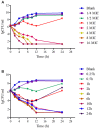PK-PD Integration Modeling and Cutoff Value of Florfenicol against Streptococcus suis in Pigs
- PMID: 29387013
- PMCID: PMC5776115
- DOI: 10.3389/fphar.2018.00002
PK-PD Integration Modeling and Cutoff Value of Florfenicol against Streptococcus suis in Pigs
Abstract
The aims of the present study were to establish optimal doses and provide an alternate COPD for florfenicol against Streptococcus suis based on pharmacokinetic-pharmacodynamic integration modeling. The recommended dose (30 mg/kg b.w.) were administered in healthy pigs through intramuscular and intravenous routes for pharmacokinetic studies. The main pharmacokinetic parameters of Cmax, AUC0-24h, AUC, Ke, t1/2ke, MRT, Tmax, and Clb, were estimated as 4.44 μg/ml, 88.85 μg⋅h/ml, 158.56 μg⋅h/ml, 0.048 h-1, 14.46 h, 26.11 h, 4 h and 0.185 L/h⋅kg, respectively. The bioavailability of florfenicol was calculated to be 99.14% after I.M administration. A total of 124 Streptococcus suis from most cities of China were isolated to determine the minimum inhibitory concentration (MIC) of florfenicol. The MIC50 and MIC90 were calculated as 1 and 2 μg/ml. A serotype 2 Streptococcus suis (WH-2), with MIC value similar to MIC90, was selected as a representative for an in vitro and ex vivo pharmacodynamics study. The MIC values of WH-2 in TSB and plasma were 2 μg/ml, and the MBC/MIC ratios were 2 in TSB and plasma. The MPC was detected to be 3.2 μg/ml. According to inhibitory sigmoid Emax model, plasma AUC0-24h/MIC values of florfenicol versus Streptococcus suis were 37.89, 44.02, and 46.42 h for the bactericidal, bacteriostatic, and elimination activity, respectively. Monte Carlo simulations the optimal doses for bactericidal, bacteriostatic, and elimination effects were calculated as 16.5, 19.17, and 20.14 mg/kg b.w. for 50% target attainment rates (TAR), and 21.55, 25.02, and 26.85 mg/kg b.w. for 90% TAR, respectively. The PK-PD cutoff value (COPD) analyzed from MCS for florfenicol against Streptococcus suis was 1 μg/ml which could provide a sensitivity cutoff value. These results contributed an optimized alternative to clinical veterinary medicine and showed that the dose of 25.02 mg/kg florfenicol for 24 h could have a bactericidal action against Streptococcus suis after I.M administration. However, it should be validated in clinical practice in the future investigations.
Keywords: Streptococcus suis; florfenicol; optimal dosages; pharmacodynamic; pharmacokinetic.
Figures







Similar articles
-
Synovial and Systemic Pharmacokinetics of Florfenicol and PK/PD Integration against Streptococcus suis in Pigs.Pharmaceutics. 2022 Jan 3;14(1):109. doi: 10.3390/pharmaceutics14010109. Pharmaceutics. 2022. PMID: 35057005 Free PMC article.
-
PK-PD Analysis of Marbofloxacin against Streptococcus suis in Pigs.Front Pharmacol. 2017 Nov 20;8:856. doi: 10.3389/fphar.2017.00856. eCollection 2017. Front Pharmacol. 2017. PMID: 29209222 Free PMC article.
-
Pharmacokinetic and Pharmacodynamic Evaluation of Marbofloxacin and PK/PD Modeling against Escherichia coli in Pigs.Front Pharmacol. 2017 Aug 21;8:542. doi: 10.3389/fphar.2017.00542. eCollection 2017. Front Pharmacol. 2017. PMID: 28871226 Free PMC article.
-
Optimal Regimens and Cutoff Evaluation of Tildipirosin Against Pasteurella multocida.Front Pharmacol. 2018 Jul 26;9:765. doi: 10.3389/fphar.2018.00765. eCollection 2018. Front Pharmacol. 2018. PMID: 30093860 Free PMC article.
-
The dose regimen formulation of tilmicosin against Lawsonia intracellularis in pigs by pharmacokinetic-pharmacodynamic (PK-PD) model.Microb Pathog. 2020 Oct;147:104389. doi: 10.1016/j.micpath.2020.104389. Epub 2020 Jul 21. Microb Pathog. 2020. PMID: 32707311 Review.
Cited by
-
Optimizing tylosin dosage for co-infection of Actinobacillus pleuropneumoniae and Pasteurella multocida in pigs using pharmacokinetic/pharmacodynamic modeling.Front Pharmacol. 2023 Sep 22;14:1258403. doi: 10.3389/fphar.2023.1258403. eCollection 2023. Front Pharmacol. 2023. PMID: 37808183 Free PMC article.
-
Optimization of florfenicol dose against Piscirickettsia salmonis in Salmo salar through PK/PD studies.PLoS One. 2019 May 13;14(5):e0215174. doi: 10.1371/journal.pone.0215174. eCollection 2019. PLoS One. 2019. PMID: 31083666 Free PMC article.
-
PK/PD integration of florfenicol alone and in combination with doxycycline against Riemerella anatipestifer.Front Vet Sci. 2022 Sep 8;9:975673. doi: 10.3389/fvets.2022.975673. eCollection 2022. Front Vet Sci. 2022. PMID: 36157174 Free PMC article.
-
Selection for florfenicol resistance at sub-MIC concentrations in Pasteurella multocida.PLoS One. 2025 Jun 24;20(6):e0327115. doi: 10.1371/journal.pone.0327115. eCollection 2025. PLoS One. 2025. PMID: 40554597 Free PMC article.
-
Synovial and Systemic Pharmacokinetics of Florfenicol and PK/PD Integration against Streptococcus suis in Pigs.Pharmaceutics. 2022 Jan 3;14(1):109. doi: 10.3390/pharmaceutics14010109. Pharmaceutics. 2022. PMID: 35057005 Free PMC article.
References
-
- Andes D., Anon J., Jacobs M. R., Craig W. A. (2004a). Application of pharmacokinetics and pharmacodynamics to antimicrobial therapy of respiratory tract infections. Clin. Lab. Med. 24 477–502. - PubMed
LinkOut - more resources
Full Text Sources
Other Literature Sources

